Using Dynamic Data in Document Engine Documents
Overview
Dynamic data is a way to use variable content in your Document Engine documents. Dynamic means that the data is characterized by continuous change.
For example, you may want a field in your document that shows the discount being given for a particular quote. Since this number changes from quote to quote, use dynamic data. The correct discount percentage--the one associated with each quote--will appear in the document output.
Tabs available on the Dynamic Content Window:

| Data |
Display the transaction XML files as a tree |
| Content Library |
Save blocks of text for re-use in other places in the document.
This feature is discussed in the topic Content Library.
|
| Complex Conditionals |
Save and use complex condition statements with multiple if...else clauses inline, within a document, without using custom XSL snippets.
This feature is discussed in the topic Complex Conditionals.
|
Administration
 Accessing the Dynamic Content Dialog Box
Accessing the Dynamic Content Dialog Box
-
Click Admin to go to the Admin Home Page.
-
Click Documents under Commerce and Documents.
The Document Engine Management Center appears.
-
Click the name of an existing document, or click the pencil icon for a document and then click Open Document Engine.
The Document Engine appears.
-
Double-click an item in the Flow tab to edit it.
The item opens in editing mode.
-
Click Dynamic Data on either the Product List or Dynamic toolbar.
The Dynamic Content dialog box appears.

 Filtering and Inserting Dynamic Data into the Document Editor
Filtering and Inserting Dynamic Data into the Document Editor
-
In the Dynamic Content dialog box, on the Data tab, use the Search field to filter the displayed data. As you type, the listed items changes to reflect the entry in the Search field. In the example below, the first screen shot shows no filtering. The second screen shot shows filtering as currency is typed into the Search: field.
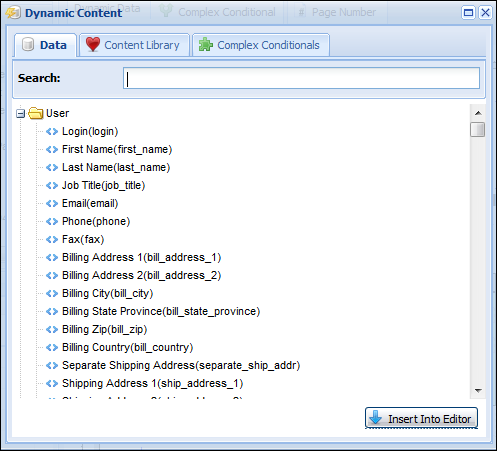
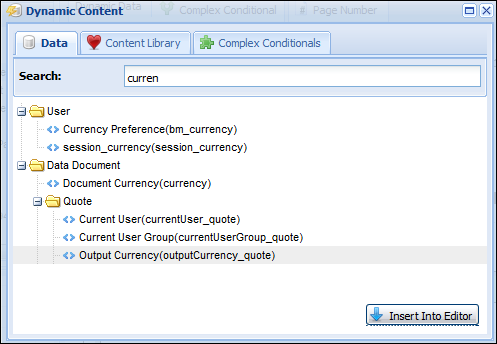
- To insert data, do one of the following:
- Drag and drop the attribute
Dragging the content into the Editor highlights the background color of the specific node.
- Double-click the attribute
This drops the desired content on the node that has been selected.
- Click Insert Into Editor.
If the cursor location is invalid, an error message appears. Click OK and select another location.
The inserted data text is highlighted in yellow and contains the Delete and Edit buttons:
- Delete

- Edit

 Image Menus in Dynamic Content
Image Menus in Dynamic Content
In the Data tab, some items have two tags: Value and Image. In your printed document, you can display the image, the text value, or both.
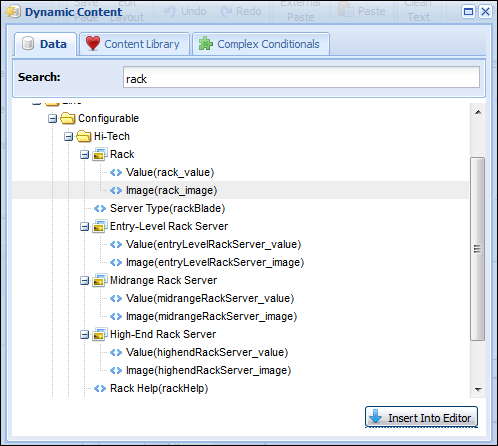
- In the Editor, place your cursor on the page where you would like to display the text image values of your configuration attribute.
- Select the Dynamic Tab.
- Select the Repeating Section icon to display the Loop Expression Editor dialog.
-
Choose Model Line Items from the Loop Over drop-down. Optional: Sort and set filters.
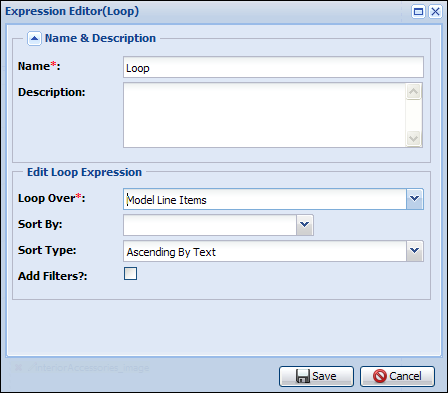
- Click Save.
- Within the loop, enter your configuration attribute content.
Place your information within a table so that the text value and its corresponding image line up.
If the parent node of an image menu is inserted into the document, only the text value will be printed. Images are displayed only when the image-specific tag is inserted into the document.
Make sure that all of your images are either JPG or non-transparent GIF. Failure to do so results in the following XSL error message: Error in processing data. Please modify XSL file.
The following screen shots shows a complete loop definition with text values and images. The text values are in the first column and the corresponding images are in the second column.
The following screen shot shows the output from the dynamic data shown in the previous screen shot.
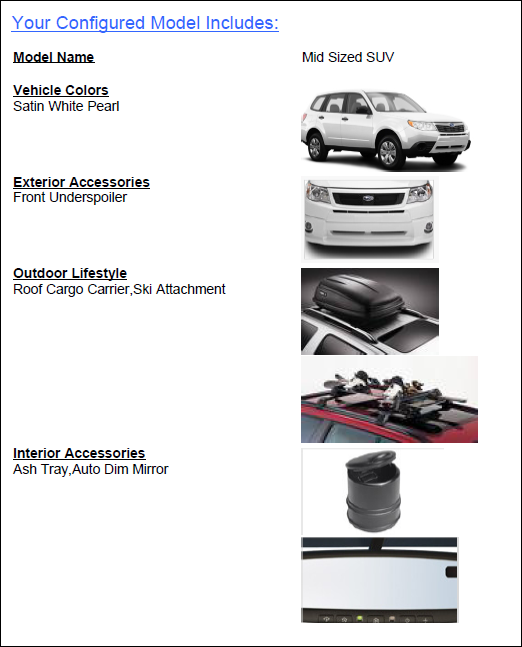
Notes
If content that is stored in a secure File Manager folder is referenced, the path must be updated.
The Image Menu section for printing simple multi-select menus and arrays will print the values in a row.
You will need to create a custom XSL or use a table to loop through your menus to achieve better formatting.
Related Topics
 See Also
See Also

![]() Accessing the Dynamic Content Dialog Box
Accessing the Dynamic Content Dialog Box
![]() Filtering and Inserting Dynamic Data into the Document Editor
Filtering and Inserting Dynamic Data into the Document Editor
![]() Image Menus in Dynamic Content
Image Menus in Dynamic Content











